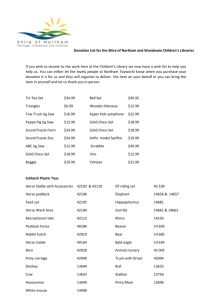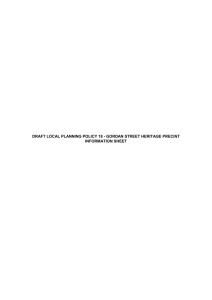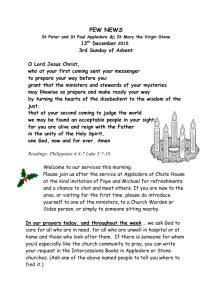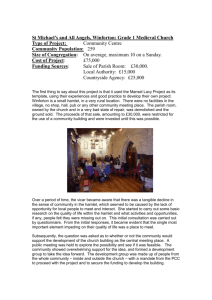A SHORT HISTORY
advertisement
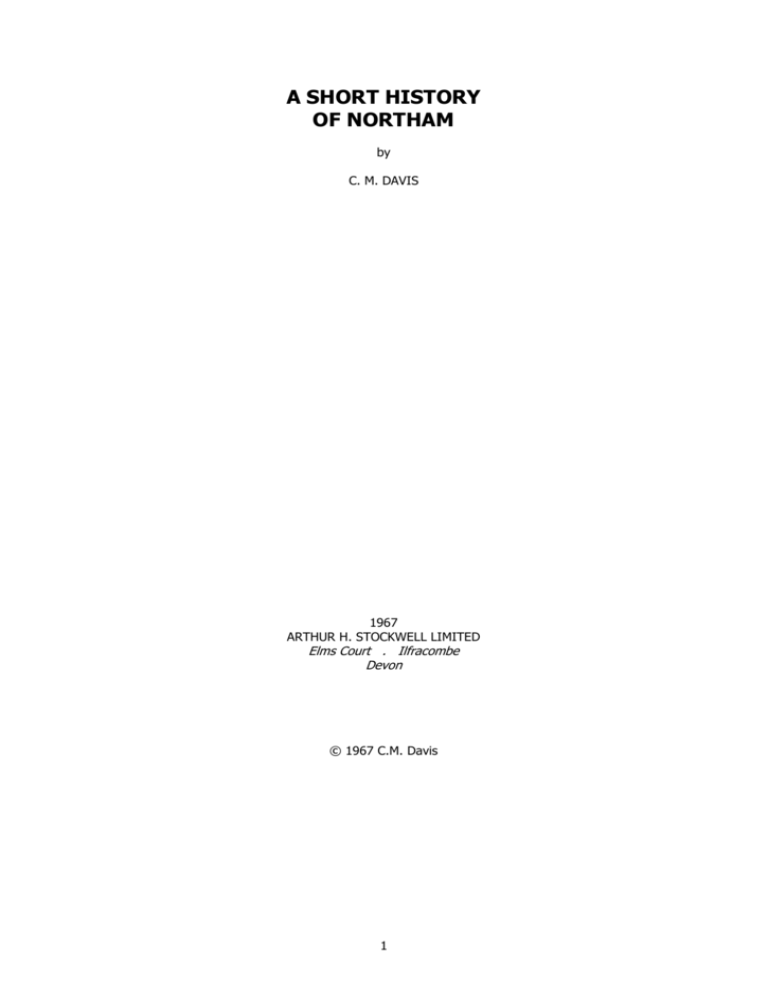
A SHORT HISTORY OF NORTHAM by C. M. DAVIS 1967 ARTHUR H. STOCKWELL LIMITED Elms Court . Ilfracombe Devon © 1967 C.M. Davis 1 A SHORT HISTORY OF NORTHAM In a book Unknown Devon, WRITTEN BY l. Du Garde Peach, Northam is dismissed as unworthy of notice; he says, “I passed through Northam, a village for the existence of which it is difficult to account. There seems to be no obvious reason why it should be there at all.” Ignorance can be the only excuse for this slight to our local patriotism, which, to past generations, was a very real thing. The old families, alas, are fast disappearing, but many newcomers (“furriners” to the old Northamites) are interested in the history of their adopted parish. It should be understood that Appledore, Westward Ho! And Orchard Hill are all included in the Urban District of Northam, also the higher part of Raleigh (where Sir Walter once lived). The name suggests that it was the centre of the three areas into which Devon was divided in Saxon times; at Portlege, the seat of the Pine Coffin family, Saxon, Norman, Tudor and Georgian architecture can all be clearly traced. The most cherished tradition of the district is connected with Appledore (said to mean in Anglo-Saxon “apple tree”). An adjacent cove known as Boat Hyde, and an ancient farmhouse “Hyde Barton” point to Saxon occupation (Hyde describing a cove). Tradition has it that in the year 878, the Danish king (or chieftain) Hubba, after ravaging the coast of South Wales, landed at Appledore with a fleet of thirty-three ships. At the earthwork fort at Kenwith (near Abbotsham) the Danes were defeated by Odun, Earl of Devon, Hubba and a thousand of his men were killed and their banner captured. Hubba was buried under a cairn at the water’s edge. A stone commemorating the battle was placed at “Bloody Corner” on the Appledore road (at the junction of the path leading to Hyde Farm and Boat Hyde) by a man named Charles Chappell, who was keenly interested in all parish affairs and a stout opponent of any attempt to interfere with its rights and privileges. Hubba’s men were said to have been buried under Bone Hill, the old name for a burying ground (Bunhill). Local place names point to the truth of the tradition – Odun Road, Hubbastone, etc. In Windmill Lane the old mill stone was dug up, also a weapon. Coins were found by workmen on the Bloody Corner site while doing road operations. Unfortunately, a passer-by bought them from the men and all trace has been lost of probably important evidence. It is said that for generations people feared to pass Bloody Corner at night, probably the relic of an ancient superstition. The remains of a Viking ship were discovered at Westward Ho! In the Domesday Book the district is recorded as “Tomouth” (the mouth of two rivers). Part of Appledore, now being used for building sites, is the Tomouth estate. The entry concerns the Burrows, a small fishing community, and two salt works – the Saxon name and larger habitations being probably ignored by the Norman invaders. Later the Manor and Church of Northam were given by William the Conqueror to the Abbey of St. Stephen at Caen in Normandy; the gift was renewed by Henry I and Edward III. Later the Manor was transferred to the Priory of Frampton in Dorset and afterwards to the College of Ottery St. Mary. Queen Elizabeth I gave the Manor to the Dean and Canons of Windsor in which gift the living still remains. The manorial rights were vested in the Royal North Devon Golf Club, later taken over by the Urban District Council. The Saxon Bishop Asser was probably the founder of the Church; it was important enough to be given by William to St. Stephen in Caen. In recent years a kyrie, sung at the time of the battle of Crecy in 1300, was found: it had been used to bind some churchwardens’ accounts. The main aisle or “yele” was added in Elizabeth I’s reign. The valuable silver communion plate then in use was sold at a time when ancient treasures were not appreciated, and earlier, when the church was restored, many such found their way into builders’ yards and second-hand shops. 2 The pulpit was rescued by Archbishop Benson in the days when he was headmaster of Wellington College, and converted into a sideboard. It was later bought by the wife of a former vicar (Mrs Payne Cook), and sent to Exeter to be restored to the church, but unfortunately it was destroyed in the blitz, as also in the London blitz were manuscripts compiled by an historian. Adjoining the church, the school for infants was originally said to have been a nunnery with an underground passage connecting it with the church. After being used as a workhouse, the present school was built by the Thorold family, being incorporated into the ancient building and receiving an endowment for its upkeep. Another ancient building on the other side of the church was the vestry room, a flight of stone steps led up to the long room used for generations as school, vestry, and for local Board meetings. The ground floor beneath was used as a prison. Northam House also has an ecclesiastical tradition; a line of cells points to a monastic institution. During the French wars it was used as a prison. One house above all others stands out in our local history – Burrough House. The home first of Burroughs, then of the Leighs and Bartons, and now of the Wrens; all of these families having common ancestors in the Burroughs. The beautiful old house was pulled down by a shipowner, Captain Yeo. Drawings exist showing gables and a courtyard; a house which could have been restored had it fallen into sympathetic hands. A plain double house has been built on the site. It was pointed out by the late Major Wren that the large outer courtyard had been used as a training ground for local armed forces at every crisis in English history for many centuries; also the aristocracy and gentry for many miles of the countryside would gather for bowling and other garden parties. The raised banks where spectators sat, are still to be seen in the grounds of the present house. In the year 1300 the Burroughs family were established here: a deed concerning property in Northam was signed by Stephen Burrough in 1302. A seafaring family, many of whom became famous, drew sailors to follow its adventures. Very many stones in the churchyard commemorate the careers of master mariners. The Golden Lion Inn recalls the name of a famous ship. In 1533 Stephen Burrough set sail in a small vessel in search of a north-east passage to China; he also visited Moscow. For 300 years his record remained unbroken. He was made Chief Pilot of England and one of the four Masters of the Queen’s Navy. His fame reached the Spanish Court, and he was invited to visit Seville where he was received with great honour and was given a pair of perfumed gloves worth six ducats. Later, a change of foreign policy sent Stephen’s brother William, who had shared in his brother’s voyages, on a raid on Cadiz in his vessel the Golden Lion , where he damaged 100 ships and destroyed three castles. In this expedition he was Vice-Admiral in Drake’s fleet. Later, he became Controller of the Navy and married a grand-daughter of the Lord Mayor of London. A nephew visited Persia and brought back treasures, silks and carpets among them. It can be imagined they were used to beautify the old home at Burrough. It will be seen from the foregoing exploits that Northam holds a worthy place in the history of our country, and many there were who played a brave part and lost their lives at sea, whose names are lost and forgotten. A male heir failing, the heiress married into the Leigh family, and for 200 years the Leighs made Burrough their home and carried on the seafaring and adventurous tradition handed down from the old family. Charles Kingsley immortalized the Leighs in his novel Westward Ho! Their tombs can be seen in the chancel of the church. From 1583 until 1663 the living was in the gift Thomas and William Leigh. It was during the Leigh period that the yele or central aisle was built. William Leigh gave an almshouse for four poor widows in 1650. History repeating itself, the male line failing once more, the Leigh heiress married a Barton, another famous naval family. Admiral Barton was known as the “Frenchman’s Terror”; with his son, he served with Nelson at Trafalgar. 3 In the Civil Wars an engagement was fought on the fort above Appledore. It is recorded in the parish register that young Prince Charles, then fifteen years old, was at Appledore on 10th July 1645, escaping from there to the Scilly Isles. Cardinal Wolsey in his early days was Rector of Torrington; he must have visited Northam, as probably did the widowed Queen of Henry VII, who lived near Torrington. Knapp House, on the Appledore Road, a short distance from Bloody Corner, was the centre of a smuggling gang 200 years ago. Thomas Benson, the owner, was famous for his daring exploits, some concerning Lundy Island being of a very doubtful character. Many very old houses still remain, among them Durrant on the Bideford Road, Northam House, Cross House, Marshford, Diddywell, Hyde and Knapp already noticed. Philip Goss, the famous naturalist, and his son Edmund, who became a noted literary man, were often visiting Durrant House, going to the shore at Westward Ho! Each day, searching the rocks for specimens. In the early days of golf the Burrows became a valuable asset to the parish, and Westward Ho! Golf Club was, after St. Andrews in Scotland, the finest in the British Isles. In 1864 J. H. Taylor, the great champion, a native of Northam, began his career on the links. Many sensational battles have been fought upon them. Royalties, Earls, Dukes, Ambassadors and visitors from all parts of the world have come to watch, and also to play on this green and beautiful common, which is also open to all natives or, as they are called, “Potwallopers”, with the right of pasture for their sheep and other cattle. Concerning the parish church, the late vicar (the Rev. E. B. Bridger, M.A.) compiled an excellent account of its history and restoration, on sale at 1s. Schools in the old days were authorized by license from the Bishop. In Northam a school was carried on by two old sailors. Finding the work beyond their strength, they applied to the Bishop for another teacher: it was then discovered that no license for a school had ever been issued! Ancient customs lingered on into the 1880s. Northam Revel was carried on for two days at Whitsuntide to celebrate the Feast of St. John the Baptist. Wrestlers attended from Devon and Cornwall, swings and roundabouts, dancing and a general jollification, also stalls were erected up and down Fore Street. Toys, sweets, famous cinnamon sticks and almond drops made by Thornbys in Barnstaple were provided for the children. As there were twelve public houses doubtless much drunkenness characterized these revels. The visiting champions would attend church on Sunday wearing their top hats, their championship belts, and other insignia of their prowess. May Day was the children’s festal day. Small maypoles were decorated with flowers and carried round the village to the strains of “London’s Burning”, “Three Blind Mice”, etc., anticipating a good harvest of pennies. Less pleasant celebrations took place on Guy Fawkes Day, said to be a relic of heathen times. “Stag hunts” paraded the streets carrying in effigy any unpopular parishioners. The effigy was burnt. This really disgraceful event took place for the last time within living memory. On Shrove Tuesday, shards were thrown into doorways, an obscure custom also observed within the memory of old inhabitants. Also remembered was a very ancient overhanging house situated between the church and the old vestry room. Northam had its share of eccentric and tragic characters. Two vicars stand out: the Rev. Isaac Gosset, who made many efforts to reform the parish, some bitterly resented and stoutly resisted. A proposal to establish allotments on the Burrows came to nothing, so fierce was the opposition. He greatly enlarged the Vicarage, and restored the church. His successor, the Rev. Dimond Churchward, was a stalwart and imposing personality. For nearly fifty years he ruled the parish as Vicar and Chairman of the local Board; being wealthy, he was able to keep a good establishment at the Vicarage. In later years a notable personality in Appledore was the Rev. Hugh C. A. S. Muller (a former R. N. chaplain), the Vicar of St. Mary’s, originally a chapel of ease, afterwards a living in the gift of the Vicar of Northam. Mr Muller was also in charge of St. Helen’s Church on Lundy Island, which he very frequently visited, giving his fellow passengers a lecture on the history and geography of the island. No accident, or death, or wreck escaped his immediate succour, and being a good 4 linguist he was much in request in dealing with foreign crews. A memorial in the church speaks of his many good works and the affection of the Appledore people and of others in the very large parish of Northam. Holy Trinity at Westward Ho! Is a beautiful church (under the parish church of St. Margaret’s). It was built in the days when the United Services College was a famous institution. Rudyard Kipling was educated here and has immortalized his old school in Stalky & Co. A tablet has been placed on the wall below his room and the whole college, now a terrace of houses, has been names Kipling Terrace. A large part of the Furze Hills was purchased by fellow students of Kipling, and by local inhabitants as a lasting memorial: “Kipling Tors” – a most delightful walk, with an outlook over land and sea unequalled in North Devon. The Council Surveyor, Mr. E. Parry, at that time was a member of the Kipling Society and he, with General Patterson (councillor for Orchard Hill) was largely responsible for the purchase of the Tors, which were handed over to the National Trust. In those early days Westward Ho! Was an animated scene. The College boys, the masters in caps and gowns were everywhere. Where houses and shops now cover the ground, huge playing fields for cricket and football stretched to the sea-front. A Roman Catholic College was built, which did not flourish long; it lasted in a ruinous condition for many years, finally being converted into flats. At the entrance to the Tors is the huge jawbone of a whale which was washed ashore on the sandhills. The dangerous coast has been the scene of many wrecks. In 1900 a terrible wreck took place in the bay. The Thistlemor of Sunderland was lost with all hands – about forty men. The funeral was a memorable event to the people of the village: many still have memories of the sad sight of many coffins piled one above the other in the churchyard. The memorial, recently restored, can be seen inside the gates opening on Bone Hill. In the churchyard, overlooking the Bar, may be seen many old stones with names of sailors buried here from other lands and far from home. The memorial and flagstaff on Bone Hill was largely due to the efforts of Captain Blackeney, R.N., a very vigorous personality who valued the Royal Navy above any other service. He lived at Hillsborough on the Westward Ho! Road for many years. The shelter built in recent years commemorates the name of Claud Strachan Carnegie, J.P., of Clevelands (now a building estate), a great patron and chairman of the local hospital, and of all efforts which made for the general good. 5
